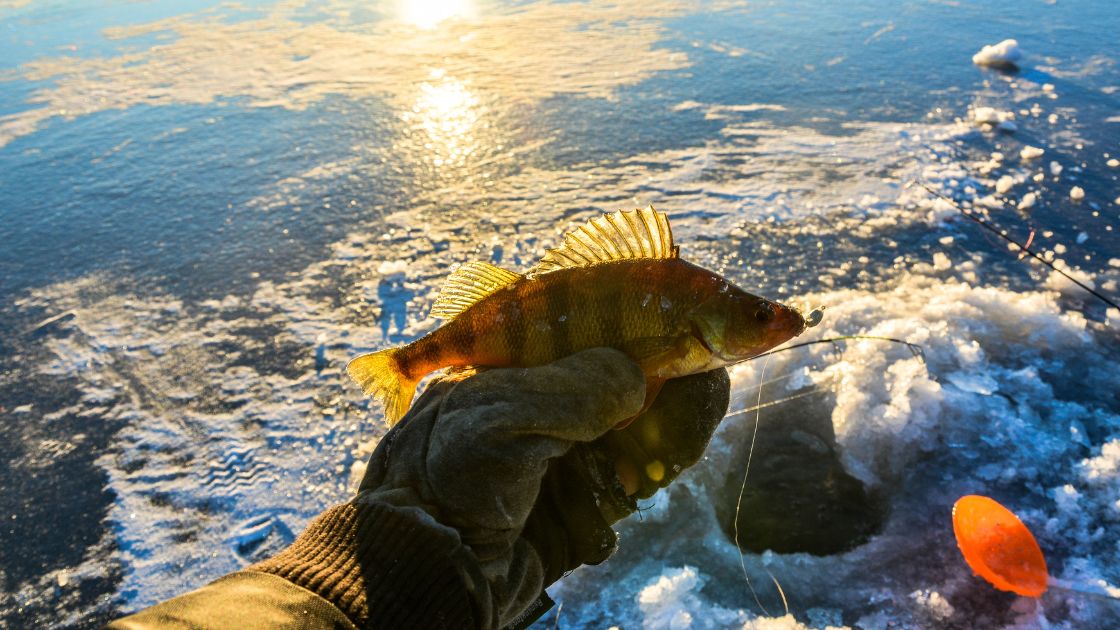Key takeaways
- The cold weather impacts fish behavior, making them less active but potentially bigger risk-takers. This offers a unique opportunity to catch something impressive if you adapt your fishing style.
- Special gear is crucial for success in ice fishing. You'll need specific rods, reels, lines, and even an ice auger to drill your fishing hole. Picking the right bait and lures tailored for the cold is also vital.
- Come prepared with essentials like a flotation suit, ice safety picks, and a first-aid kit.
Ice fishing is a unique and exhilarating experience that allows you to catch fish in a way you've probably never tried before: standing on a frozen lake or river, peering into a hole you've just drilled through the ice, and pulling up a fish on a line.
For the uninitiated, the idea of ice fishing might raise some eyebrows. But once you give it a shot, you'll find it's an enjoyable winter pastime that may keep you fishing all year round.
The winter months also offer a unique opportunity to catch not just any fish, but potentially a lunker (Don't miss our post on How Can I Catch Bigger Fish? if you're interested in reeling in one). Why? Because fish are hungrier in the winter, making them more willing to take risks they wouldn't usually take.
What sets ice fishing apart from your regular fishing trips? Unlike traditional fishing, ice fishing calls for specialized gear like shorter and lighter rods, ice augers for drilling holes, and specific fishing lines designed for the cold.
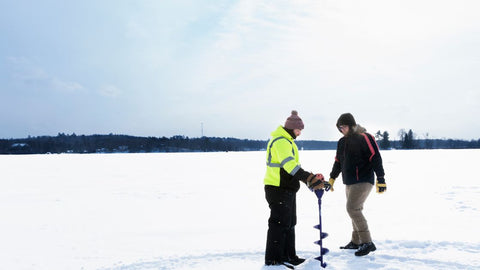
The locations are different too; you'll typically find yourself on a frozen lake or river rather than a flowing stream or ocean bay. And of course, this is a winter activity, filling in the gap for those who want to fish year-round.
The behavior of fish also changes with the temperature; they're generally less active during the colder months, requiring you to adapt your techniques to attract and catch them. Even the bait and lures you'll use are specialized for ice fishing, differing from what you'd use in warmer seasons.
This is your complete guide to ice fishing, covering everything from tips for beginners to the equipment you'll need, effective techniques, your ice fishing rig, and crucial safety measures.
So pack your winter fishing gear, and see you on the ice!
Table of Contents
- Fish Behavior During Winter
- Ice Fishing Essential Equipment or Gear
- Rod, Reel, and Line
- The Ice Auger
- Lures, Bait, and Tackle
- The Ice Scoop
- The Multi-Purpose Bucket
- Dressing for Success
- Safety First
- Ice Fishing for Beginners
- Setting Up Your Ice Fishing Rig
- Top Ice Fishing Techniques
- Jigging
- Tip-Ups
- Deadsticking
- Hole-Hopping
- Fish Finders and Underwater Cameras
- Look for Contours
- Stay Quiet and Observe
- Final Thoughts
Fish Behavior During Winter
Understanding fish behavior during the winter months can significantly improve your ice fishing success. One key change is the slowed metabolism of fish, meaning they become less active and require less food. Additionally, as water temperatures drop, fish often move to deeper waters where temperatures are more stable, making them a bit more challenging to locate.
Certain species like brook trout may be particularly hungry during the winter, making live bait or small jigs effective for targeting them. Fish may also adjust their feeding patterns, with species like walleyes, crappie, and perch becoming more active during low-light periods. Just like humans, fish can feel the cold, and this sensitivity can make some less active or even dormant. Being aware of these behavioral shifts can help you adapt your ice fishing techniques for a more fruitful outing.
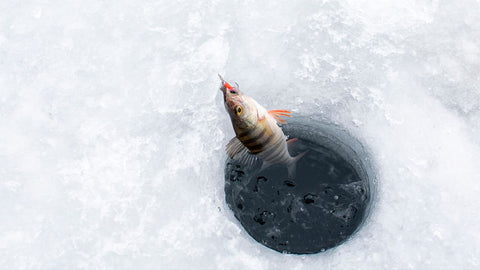
Don’t miss this post on How Fish Survive in Frozen Water for more insights on fish behavior and biology!
Ice Fishing Essential Equipment or Gear
When it comes to ice fishing, having the right gear can make all the difference. Let's go through the essentials you'll need for a successful day on the ice.
Rod, Reel, and Line
First and foremost, you'll need a specialized ice fishing rod and reel combo. These are usually designed to be shorter and lighter, making it easier to navigate the small holes you'll be fishing through. Pair this with a line that's specifically suited for cold water conditions, such as a 6lb fluorocarbon, to ensure optimal performance
The Ice Auger
An ice auger is your gateway to the underwater ice fishing world. This tool is used to drill holes through the ice, giving you access to the fish below. Hand augers are a practical and affordable option for beginners, especially when dealing with less than a foot of ice. There are also gas, electric, and propane-powered ice augers available in the market.
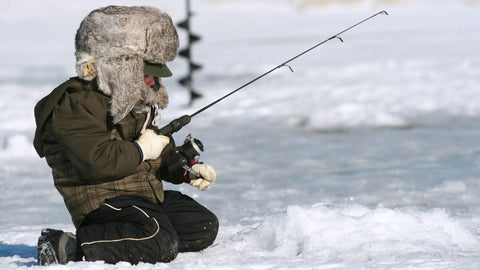
Lures, Bait, and Tackle
Selecting the right lures and bait for ice fishing is crucial. The type of fish you're targeting will dictate your choices here. Some common types of ice fishing bait include: minnows, nightcrawlers, salmon eggs, maggots, wax worms, and mealworms. Meanwhile, some common ice fishing lures are jigs, spoons, and plastic worms. Don’t forget to stock up your tackle box with other terminal tackle like weights, hooks, and bobbers.
The Ice Scoop
After drilling your hole, you'll find it filled with slush and ice shavings. An ice scoop is indispensable for clearing this out, making it easier to drop your line and land fish.
The Multi-Purpose Bucket
A bucket with around 5 gallons of capacity serves multiple roles in your ice fishing setup. It can carry your equipment, store your catch, and even act as a makeshift seat. Some buckets come with insulated compartments to keep your bait fresh.
Dressing for Success
Layering is key when it comes to ice fishing apparel. A combination of shirts, fleece or water-resistant zip-ups, and wind-resistant outer layers will keep you warm and dry. Don't forget water-resistant boots, mittens, and a hat to cover your ears.
Safety First
Safety gear is non-negotiable. These tools are your lifeline should you find yourself in a precarious situation on the ice. Make sure you're geared up with essentials like a floatation suit, jacket, or bibs; these can be a lifesaver if you happen to fall through the ice.
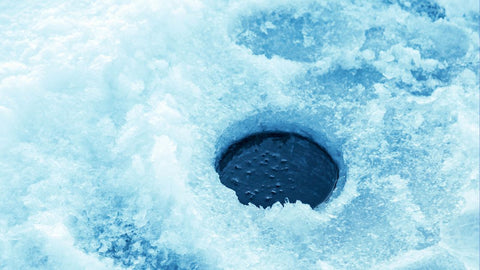
Handheld tools like ice safety picks are crucial for gripping the ice to pull yourself out of the water. Don't forget a spud bar or chisel to test the ice's thickness and strength before you set up. A ruler can also do the trick for measuring ice thickness. Keep a floating rope handy; it's a must-have for helping someone who's fallen through. A whistle is another small but vital item for signaling for help. And of course, a basic first aid kit stocked with bandages, antiseptic, and a thermal blanket should always be within reach.
Head over to our previous post for a checklist of fishing essentials.
Ice Fishing for Beginners
If you're new to ice fishing, there are some key tips to keep in mind for a successful and safe outing.
First off, choosing the right location is crucial. Stick to popular ice fishing spots or consult local anglers for recommendations. Steer clear of areas where brooks or streams enter, as the ice may be weaker there. It's always a good idea to fish with a group; not only is it more enjoyable, but it's also safer and allows you to set more traps.
For beginners, starting with tip-ups is a smart move. These are ice traps that you can set and leave unattended, making it easier to monitor multiple holes at once.
When it comes to bait, live minnows or wax worms or any other bait with a high fat content are your best bet initially. As you gain experience, you can start experimenting with jigs, spoons, or other artificial lures. If you have access to a power auger, don't hesitate to drill multiple holes to increase your chances of finding active fish. Comfort is key, so dress in layers and bring along extra clothing, hand warmers, and hot beverages.
Patience and observation are essential in ice fishing. Keep an eye on your tip-ups or jigging rod for any signs of fish activity. If you have a fish finder or underwater camera, that can be a big help. Lastly, never compromise on safety. Always check the ice thickness and quality before you venture out.
Looking for a fishing shirt for your next angling adventure? Check out these bestsellers!
Setting Up Your Ice Fishing Rig
- A 24 to 36-inch rod is suitable for most ice fishing situations. These shorter, lighter rods are specifically designed for ice fishing.
- Equip your rod with a 2000-series spinning reel or a baitcaster, depending on the position of the reel seat relative to the line guides.
- Spool up the reel with 2 to 3-pound test monofilament or fluorocarbon line.
- For an effective ice fishing setup, start by attaching a small 1/64-ounce jig to the end of your line, choosing a color and style that mimics local baitfish.
- To help your jig descend more quickly, add one or two small lead split shot weights above it, adjusting the weight based on the fishing depth.
- Finally, bait your jig with live options like a wax worm or a small minnow, ensuring it's securely threaded onto the hook for a natural appearance.
Top Ice Fishing Techniques
Jigging
This is the most common and fun way to ice fish. Use a short, light jigging rod equipped with a spring bobber for better sensitivity. Drop your baited hook or jig to the bottom and then reel it up a few inches. Start jigging by moving your rod tip up and down to imitate the movement of a small fish or insect. Vary the speed and depth of your jigging to attract different types of fish.

Tip-Ups
These are ice traps that can be set and left unattended while you wait for a fish to bite. They are a good option for beginners, as they require less active fishing and allow you to monitor multiple holes at once. Set your tip-up by attaching a live bait rig or a jigging spoon to the line and then placing the tip-up over the hole. When a fish bites, the flag on the tip-up will pop up, indicating a strike.
Deadsticking
This is a passive ice fishing technique where you suspend a baited hook or jig just off the bottom. This method works well for finicky or inactive fish. Use a longer, more sensitive rod and a small, lightweight jig or bait.
Hole-Hopping
If you're not having luck in one spot, try moving around and drilling multiple holes to cover more water. Use a portable ice auger to quickly drill holes in different areas and then move from hole to hole, fishing each one for a short period of time. This technique can help you locate active fish and increase your chances of success.
Fish Finders and Underwater Cameras
If you have access to tools like fish finders or underwater cameras, they can help you locate fish and determine their behavior and depth, allowing you to adjust your fishing techniques accordingly.
Look for Contours
Look for areas with rock piles, weed beds, or dramatic contours, as these are often good spots for fish to gather. Drill a hole in the ice using an ice auger, and make sure the hole is wide enough for your jigging rod to move freely.
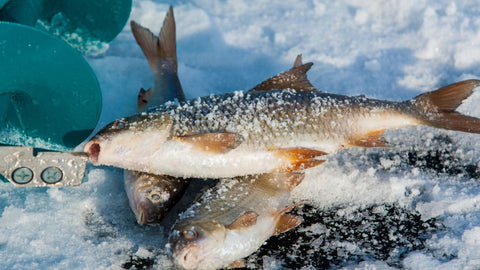
Stay Quiet and Observe
Ice fishing requires patience and observation. Keep noise to a minimum as you approach the fishing area and limit your drilling. Watch for any signs of fish activity, such as bubbles, on your fish finder or underwater camera, and adjust your fishing techniques accordingly.
Here’s a related post on Tips for Fishing During Winter.
Final Thoughts
Ice fishing is a unique twist on the fishing experience, offering a winter adventure that's both challenging and rewarding. We've walked you through everything you need to know, from beginner-friendly advice to the specialized gear you'll need. We've also talked about effective techniques like jigging, tip-ups, and deadsticking, as well as the crucial safety precautions to keep in mind. So gear up, stay safe, layer up, and relish the unique thrill of reeling in a catch through a hole in the ice!
Don't miss our top posts!
Catch and Release versus Catch and Keep
Fishing Scents/Attractants: Do They Work?
MOST READ NEWS:
How To Use Your Fishing Records to Catch More Fish
Track your fishing trips, analyze patterns, and refine your techniques with a fishing log to catch more fish on every outing!
Solo Fishing Safety Tips: Stay Safe and Enjoy the Outdoors
Learn essential solo fishing safety tips: gear checklist, boat safety, emergency preparedness, weather monitoring & fishing location scouting. Stay safe on the water.
Secrets to Winter Fly Fishing Success
Master winter fly fishing with expert tips on trout behavior, essential gear, and proven techniques. Learn the secrets to catching more fish in cold weather.
How Cold Water Changes Fish Behavior: Insights for Anglers
Explore how cold water affects fish behavior and fishing techniques, enhancing your angling success and strategy.
Is Tech Making Fishing Too Easy? Exploring Forward-Facing Sonar (FFS)
Learn about forward facing sonar in fishing - what it is, how it works, rules for tournaments, ethics, and tips for finding fish with this game-changing technology.
Plan Your Best Fishing Trip Yet this 2025: A Complete Guide
Plan your fishing trip this off-season. Learn to choose destinations, prep gear, pick bait, and trust Baitium for expert tools and tips!
15 Fishing Resolutions for 2025: Set Yourself Up for Success
Discover 15 essential fishing resolutions for 2025: tackle organization, gear maintenance, angling techniques, conservation tips, tournament prep, and fishing safety guidelines.

